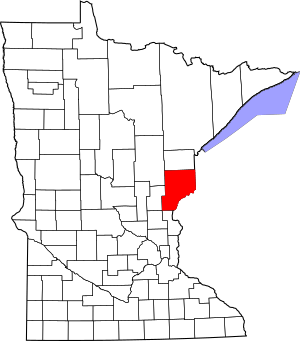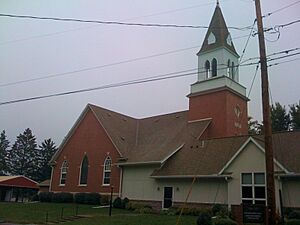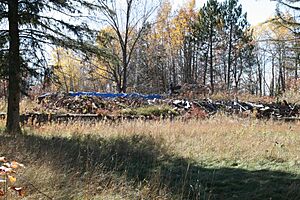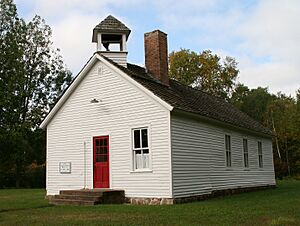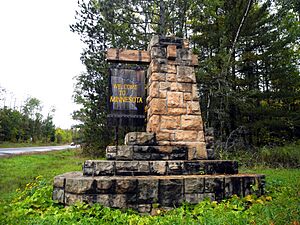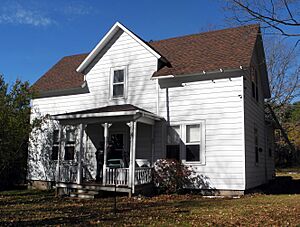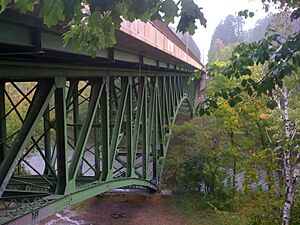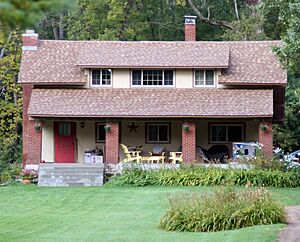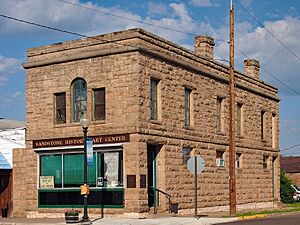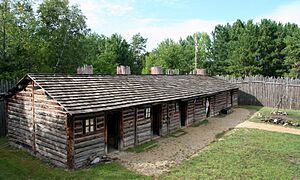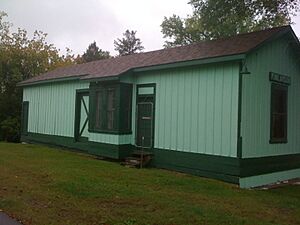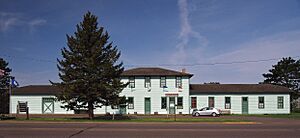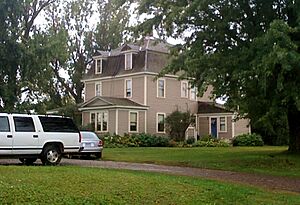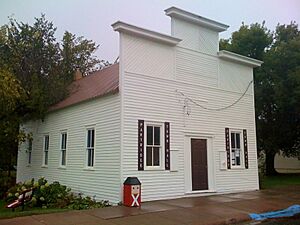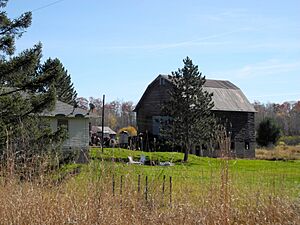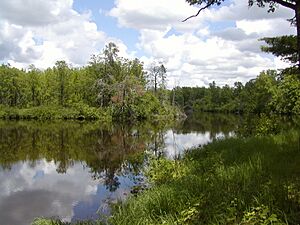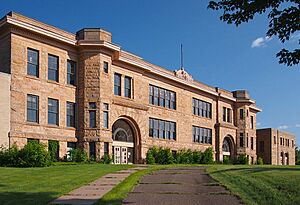National Register of Historic Places listings in Pine County, Minnesota facts for kids
Have you ever wondered about old buildings and places that tell a story? In Pine County, Minnesota, there are many special spots that are listed on the National Register of Historic Places. This is like a special list of important buildings, areas, and sites across the United States. These places are chosen because they have a lot of history or are great examples of how people lived and built things in the past.
There are 21 places in Pine County that are currently on this list. One of them is even a "National Historic Landmark," which means it's extra important! There were also three other places that used to be on the list but aren't anymore. Let's explore some of these cool historic places!
Contents
- Cool Historic Places in Pine County
- Bethlehem Lutheran Church
- Cloverton School
- District No. 74 School
- John Doboszenski Farmstead
- Hinckley Fire Relief House
- Hinckley State Line Marker
- Louis Hultgren House and Sand Pit
- Kettle River Bridge
- Kettle River Sandstone Company Quarry
- Peter P. Kilstofte Farmstead
- Minneapolis Trust Company Commercial Building
- North West Company Post
- Northern Pacific Depot (Finlayson)
- Northern Pacific Depot (Hinckley)
- John A. Oldenburg House
- Partridge Township Hall
- Red Clover Land Company Demonstration Farm
- St. Croix Recreational Demonstration Area
- Sandstone School
- Arnold Schwyzer Summer House and Farmstead
- Stumne Mounds
- Willow River Rutabaga Warehouse and Processing Plant
- Places No Longer on the List
Cool Historic Places in Pine County
Bethlehem Lutheran Church
This beautiful church in Askov was built in 1915. It's made of brick and has a style called Gothic Revival. This means it looks a bit like the grand old churches from the Middle Ages, with pointed arches and tall windows. It was built for a community of Danish Americans, showing their history and faith in the area.
Cloverton School
The Cloverton School was built in 1920. It was a brick school with special stone decorations. Sadly, this school building has been taken down since it was first listed.
District No. 74 School
Imagine going to school in a log cabin! The District No. 74 School in Danforth Township started as a log school in 1899. Later, in 1909, a wooden addition was built onto it. It's a great example of early schools in the area.
John Doboszenski Farmstead
This farm near Willow River dates back to 1894. It belonged to John Doboszenski, who was an immigrant farmer. This farm shows us what life was like for people who came to Minnesota and built a life by farming the land.
Hinckley Fire Relief House
After the terrible Great Hinckley Fire in 1894, many people lost their homes. This house in Sandstone is a special example of the emergency homes that were built to help people. It shows how communities came together to rebuild after a disaster.
Hinckley State Line Marker
This marker, built in 1942, is a sandstone sign that welcomed people into Minnesota. It's made in a style called National Park Service rustic, which uses natural materials to blend in with the environment. It's a cool piece of roadside history!
Louis Hultgren House and Sand Pit
This house, built around 1896, belonged to Louis Hultgren, a Swedish immigrant. He also ran a sand quarrying business nearby. This site shows us how early industries, like mining sand, helped the region grow.
Kettle River Bridge
This bridge, built in 1948, crosses the Kettle River in Sandstone. It's a steel deck truss bridge, which means it uses a strong framework of triangles (a truss) to support the road above. Bridges like this are important for travel and trade.
Kettle River Sandstone Company Quarry
This site in Sandstone was once Minnesota's biggest sandstone quarry. From 1885 to 1919, a lot of sandstone was dug out here. Today, it's a city park, but you can still imagine the busy work that happened here long ago.
Peter P. Kilstofte Farmstead
This dairy farm in Askov, built in 1913, belonged to Peter P. Kilstofte, a well-known builder. The farmhouse is in the American Bungalow style, which was popular for its cozy and practical design. The farm also has a unique silo made of rubble stone.
Minneapolis Trust Company Commercial Building
This building in Sandstone was built by a company that helped rebuild the town after the Great Hinckley Fire. It's made of local sandstone, showing how people used materials from their own area. Today, it's the Sandstone History and Art Center, a place where you can learn about the past and see art.
North West Company Post
West of Pine City, you can find a reconstructed fur trading post from 1804. This was a place where the North West Company traded furs with Native Americans and trappers. Today, it's a living history museum run by the Minnesota Historical Society, where you can see what life was like back then.
Northern Pacific Depot (Finlayson)
This train station in Finlayson was built in 1909. It's a "board-and-batten" style depot, meaning it has wide boards with narrow strips (battens) covering the seams. Train depots were very important for towns, bringing people and goods.
Northern Pacific Depot (Hinckley)
This train station in Hinckley was rebuilt in 1895 after the original one was destroyed in the Great Hinckley Fire. It's a wooden building that now houses the Hinckley Fire Museum, where you can learn all about that famous fire.
John A. Oldenburg House
Built around 1896, this house in Finlayson belonged to John A. Oldenburg, an important businessman. It's built in the Second Empire architecture style, which often features a special type of roof called a mansard roof.
Partridge Township Hall
This community hall in Askov was built in 1901. It has a "false-fronted" design, which means the front of the building is taller than the rest, making it look more impressive. It was a place where people gathered for meetings and events.
Red Clover Land Company Demonstration Farm
Around 1915, this farm in New Dosey Township was built to show people how to farm the land. It was a "demonstration farm" to help new settlers learn the best ways to grow crops and raise animals.
St. Croix Recreational Demonstration Area
This large area, now part of Saint Croix State Park, was developed between 1934 and 1943. It was a project to turn poor farmland into a place for recreation. Groups like the Civilian Conservation Corps (CCC) and the Works Progress Administration (WPA) helped build 164 structures here. These groups were part of government programs during the Great Depression that gave people jobs building parks and other public works. The buildings are in the National Park Service rustic style, using natural materials. It's the largest collection of these types of buildings in Minnesota!
Sandstone School
The Sandstone School was built in 1901 using local sandstone. It combines two styles: Romanesque Revival (which uses round arches and strong, heavy walls) and Classical Revival (which looks like ancient Greek and Roman buildings with columns). An addition was built in 1910. It's a grand old school building!
Arnold Schwyzer Summer House and Farmstead
This summer home and dairy farm near Sandstone was built between 1902 and the 1920s. It shows how wealthy people from cities would build special retreats by lakes in Pine County. Today, it's the Audubon Center of the North Woods, a place for nature education.
Stumne Mounds
The Stumne Mounds are ancient earth mounds that date back to about 600 CE. These mounds are special because they were built by early people and tell us about their history. Their exact location is kept secret to protect them.
Willow River Rutabaga Warehouse and Processing Plant
This building, constructed in 1935, was used for processing and storing rutabagas, which are a type of root vegetable. It was the only facility in Minnesota specifically for this local crop, showing how important rutabagas were to the area's economy.
Places No Longer on the List
Sometimes, places are removed from the National Register of Historic Places. This usually happens if they are torn down or changed so much that they no longer have their historic value.
Bridge No. 1811 over Kettle River
This bridge, built in 1916, was a Pratt truss bridge. It crossed the Kettle River near Rutledge. Sadly, it was taken off the list in 2005 because it was torn down in 2004.
This armory in Pine City was built in 1914. An armory is a building where military equipment is stored and soldiers train. It was removed from the list in 2001 because it was demolished in 2000.


